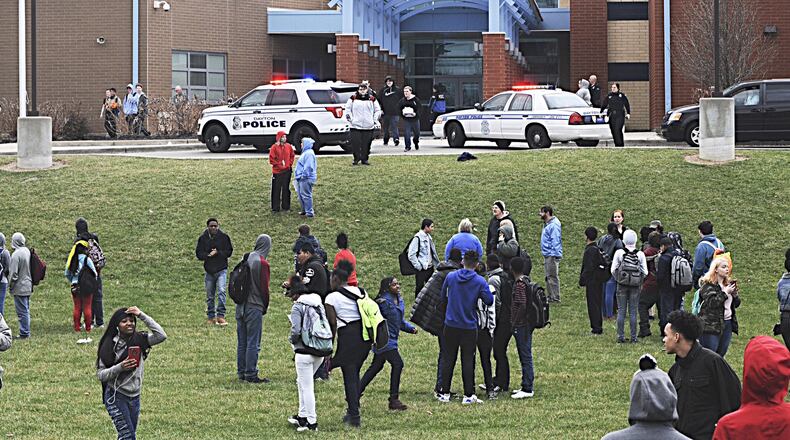“The court realizes the clear majority of these threats are nothing more than a misguided practical joke – that I don’t find funny by the way – or a horrible way to try and get out of fifth-period gym class,” Kirby said in court. “But the truth to the matter is that since Sandy Hook occurred back in 2012, there have been more than 400 people shot in over 200 school shootings.”
MORE: 7 Butler County threats since latest school shooting
Kirby, for five years the juvenile court judge in this growing community between Dayton and Cincinnati, said polygraph tests provide additional insight in balancing the best interest of the child facing detention with the danger to the community from the threats made against their classmates or teachers.
“Courts and schools all over our country are facing this issue and struggling with how to contain it and, more importantly, how to prevent it,” Kirby said a week ago during one of two hearings that day for boys held since making threats against their schools.
Kirby’s use of polygraphs, apparently unique in the Dayton region, came after alleged school threats from 10 children who range in age from 10 to 17 and who attend public and private schools around Warren County.
MORE: Hundreds of students walk out of schools across southwest Ohio
The judge cited a report indicating the incidence of the threats had jumped from 10 to 75 a day nationwide in the days after the mass shooting at Marjory Stoneham Douglas High School in Parkland, Fla. In a later hearing, he flashed a newspaper story tallying 600 false threats since the shooting, which prompted nationwide walkouts on Wednesday by students intent on pressing lawmakers for more action to make their schools safer.
On Wednesday, Kirby extended the use of the polygraph to cases occurring before the Parkland tragedy, ordering — with agreement by the defense — a 15-year-old boy, who said via social media that he would “shoot up” his school” on Jan. 30, to pass a polygraph.
Other juvenile courts in southwest Ohio indicated they have seen similar spikes in the number of school threat cases.
MORE: Springfield students admits to school threat
“Every time there is a school-related shooting, there is a significant spike in our court,” said Rob Clevenger, director of the Butler County Juvenile Court.
For example, in the month after 15 people, including both shooters, were killed on April 20, 1999, at Columbine High School in Colorado, Butler County juvenile court saw 35 new school threat cases compared to 10 the entire previous year, according to Clevenger.
In Greene County since Feb. 14, court officials said six students were charged with making false alarms, one of the most common charges filed in school threat cases.
“This is not typical,” Court Administrator Amy Lewis said in an an email.
MORE: School officials rush outside to see if former student attempting to fly into building
Like officials in Greene and Butler counties, Assistant Montgomery County Prosecutor Julie Bruns indicated polygraphs were not being used in the juvenile court to gauge the seriousness of school threat cases.
“The result of a polygraph test is not admissible in court unless the parties agree that it will be admissible before the test is taken. Our office has not done so in any of the cases you mention,” Bruns said in an email.
Kirby acknowledged polygraphs “were controversial in nature” and, although used to answer questions about sex offender rehabilitation, not usually used to measure a child’s honesty in Warren County.
RELATED: 2nd Warren County 10-year-old avoid detention in school threat case
In two cases involving 10 year-olds, Kirby was not able to use a polygraph because the examiner declined to test anyone younger than 12, court officials said.
Still, Kirby said he would continue to rely on the test, commonly known as a lie detector, rather than answers from the child or parents.
“It’s the only real way we can get inside a child’s mind to find out what they are thinking and what they are doing,” he said in ordering the first ones with agreement from the defense.
The judge said the Ohio Supreme Court has ruled polygraphs are acceptable under conditions, including “to protect the public interest and safety.”
“Another is to provide for the care and protection of the juvenile who comes before a court,” he said.
Kirby also continued to question why schoolchildren make more threats after a real shooting.
Clevenger said those accused are generally good kids aware of the history of school shootings in America and sensitivity in schools afterward. In addition, he said some anticipate getting media attention as a result of the threats, most of which are made through social media.
MORE: Schools change rules to combat social media used in school threats
“More often than not, these are kids that have had no involvement in the juvenile justice system,. That’s pretty much the norm,” he said.
Patti Ahting, associate director of Mental Health Recovery Services of Warren and Clinton Counties, said “more likely a combination of factors” contributed to otherwise good kids making school threats.
“The decision-making part of the brain, responsible for a youth’s ability to plan and think about the consequences of actions, solve problems and control impulses, continues to develop into the mid-20’s,” Ahting said in an email.
“Thus, youth may make impulsive comments and not realize the seriousness of their statements. This is particularly the case when threats are stated over social media where there is the illusion of anonymity,“ she added.
MORE: Frustration builds over increase in school threats nationwide
Family issues, alienation, conflicts or failures can play a part, Ahting added. “Or, the youth may be expressing a desire or need for control, attention, respect.”
Depression and suicidal tendencies can also help lead a child to make a school threat as “a call for help or an expression of anger, disappointment, humiliation or frustration,” she added.
In addition, Ahting said “school climate and culture” can fuel a school threat.
MORE: How to help, recognize at-risk students
“If a student sees an imbalance in the approval, attention, or prestige given to some students over others, this may lead to frustration and resentment. The youth may feel bullied at school and unprotected by the administration,” Ahting said.
“Identification of youth who may be struggling is key. Family, school, and community members should be on the look-out for youth who may be exhibiting some of these factors. Intervention through mental health treatment and adult support/mentoring can help prevent school threats,” she said.
About the Author

